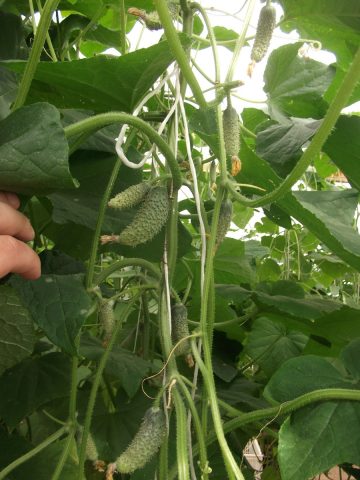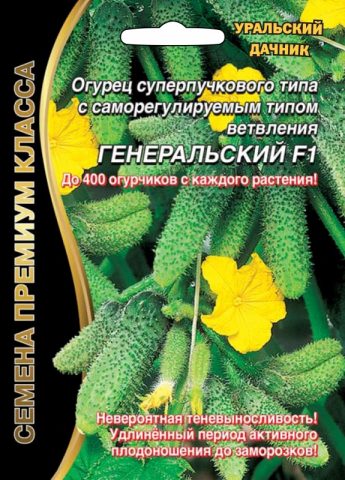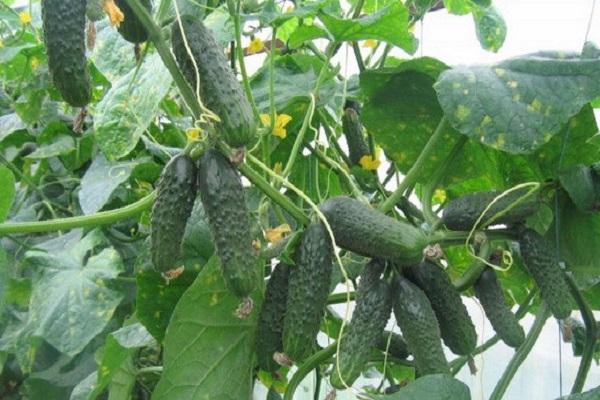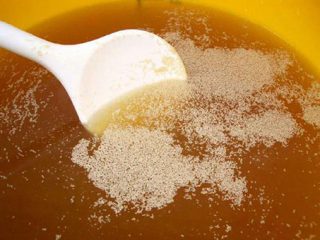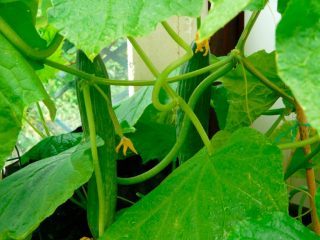Content
Cucumber Generalsky is a representative of a new generation of parthenocarpic cucumbers, suitable for growing in open ground and in greenhouses. The high yield of the variety is based on the plant's ability to create more than ten ovaries per node. Cucumber General, bred by scientists of the agricultural firm "Uralsky Dachnik", in a small area shows an over-yield, which is equal to several lashes of familiar varieties.
Description of Generalsky cucumbers
The bush of the variety is developing rapidly, the main whip sometimes exceeds 2 m. The General'skiy cucumber plant belongs to a self-regulating type of branching. As the central liana grows and cucumbers are formed on it, the lateral lashes do not form or develop very slowly. Only with the end of fruiting, after harvesting the fruits, the lateral processes on the main lash actively increase. The scourges of the second stage of Generalskiy cucumbers fill an impressive space. Accompanied by seeds, producers emphasize that the variety needs to be placed 2 seedlings per 1 sq. m. Stems of the variety are medium-leafy.
The flowers of the hybrid General's female type are formed in bunches in the axils of the leaves. The new generation variety is super-beam, with good agricultural technology, up to 10-12 cucumbers are formed in one node. The fact is confirmed in the video of various gardeners with reviews about General's cucumbers and photos of whips with greens during fruiting.
Description of fruits
Cucumbers of the early ripening variety Generalskiy gherkin type. Fruits are uniform, slightly ribbed. At the stage of technical maturity, they reach 9-12 cm in length, up to 3 cm in diameter, weighing 80-90 g. General's cucumbers at the beginning of the formation of gherkins are distinguished by a high degree of pubescence of a dark green skin with numerous pimples. With the growth of the fruit, the tubercles increase, by the harvesting phase, their location on the fruit body of the cucumber is characterized as moderate. The pulp is firm, crispy, without voids, creamy greenish, with a small oblong seed chamber.
The Generalskiy cucumber, according to reviews, has a pleasant, refreshing pulp taste, with the expected vegetable aroma. Fruits of a variety of universal direction:
- they look appetizing in fresh salads and cuts, largely due to small undeveloped seeds;
- gherkins with excellent qualities for lightly salted blanks, since the presence of a sufficient number of tubercles and the delicate structure of the flesh provides quick impregnation of vegetables with the prepared brine;
- harvested green cucumbers are suitable for raw materials for canning assorted salads and whole-fruit pickling.
The main characteristics of the variety
Initially, the cucumber is a gentle southern plant, therefore, it requires for development:
- a lot of light;
- heat in the range from 20 to 28-29 ° C, the boundaries of the comfortable mark;
- moderately humid air and soil.
Breeders have provided an early ripening version of the vegetable that is capable of bearing fruit in an unpredictable Siberian summer with sudden drops in temperature, especially at night, without sacrificing yield. Due to this property, General'skie Zelentsy are harvested in September, if there is no frost. The supply of sufficient moisture depends on:
- the rate of formation and growth of gherkins;
- fresh taste, no bitterness;
- the quality of the density of the pulp, including the absence of voids.
The unpretentiousness of the General's gherkins is also expressed in the good shade tolerance of the plant, which the authors of the hybrid insist on. Fruiting continues at the beginning of autumn, when the degree of sunshine is significantly reduced.
Yield
Experts attribute the new cucumber variety Generalskiy f1 to the super-beam type of fruiting, which ensures its over-yielding capacity. The authors declare the collection of 400 cucumbers from one plant of the early ripening General's hybrid, which has developed not only resistance to temperature changes, but also a long fruiting period. Zelentsy is harvested from mid-summer to September or October, depending on weather conditions.
The standard agricultural technique for growing new generation super-beam parthenocarpic cucumbers requires:
- sufficient light and heat at the initial stage of seedling growth;
- moderate soil moisture;
- the availability of sufficient nutrients for a rapidly developing and ovary-producing plant;
- the formation of lashes.
Pest and disease resistance
Cucumbers Generalskiy f1 are resistant to pathogens of fungal diseases at the genetic level, as the authors of the variety inform consumers. Plants thrive in greenhouses and outdoors. It is worth taking care of protecting the whips and leaves from the ubiquitous aphids and ticks, which can reduce the expected yield.
Pros and cons of the variety
Judging by the description of the variety and the photo, Generalskiy cucumbers have no equal in merits:
- super-yield;
- early maturity;
- stability and duration of fruiting;
- self-regulation of branching;
- the versatility of the whip and fruit;
- high marketability of products;
- resistance to temperature extremes and diseases.
The hardy variety of Generalskie cucumbers in the reviews receives the best marks, without mentioning the shortcomings.
Growing rules
The variety is grown by seedling method if you want to get an earlier harvest. Also, Generalskiy cucumber seeds are sown directly into open ground. In the middle zone and Siberia, the grains are first germinated.
Sowing dates
For growing seedlings in the garden, seeds of the Generalsky variety are sown in separate pots in early May, and for greenhouses - in the third decade of April. Sprouts germinate at 23 ° C in a week. The containers are kept on a light windowsill or in a greenhouse with moderate watering. After the appearance of the second leaf and 4 days before transshipment, the cucumbers are fed with complex fertilizer. By the end of the month, at the beginning of June, the 4th leaf appears on the seedlings. In this phase, the cucumbers are transferred to a permanent place. In the greenhouse, seeds are sown in the soil in mid-May, and in the gardens - in late May or early June.
Site selection and preparation of beds
Tall, warm and fertile beds with compost or humus will speed up the picking of cucumbers and support the intensive development of the plant. They are arranged in a well-lit place protected from northern winds. When preparing the beds, add 1 sq. m by:
- 50 g of wood ash;
- 25 g nitrophoska;
- 25 g superphosphate.
How to plant correctly
The depth of the holes is slightly higher than the pots in which the seedlings developed. Cucumbers of intensive development are placed on two roots per 1 sq. m. Between the holes and rows, 50 cm recede. Before transshipment, the container with seedlings is watered abundantly in order to easily remove the earthen ball without damaging the delicate roots of the cucumbers. After 2 days, the lashes are tied to the supports.
Follow-up care for cucumbers
Superbeam varieties are watered with abundant warm water, once a week they are fertilized with complex preparations. For the constant setting of new fruits, greens are harvested daily. The soil is slightly loosened so that air can freely penetrate to the roots of the plant. The formation of lashes of General's cucumber begins already before transshipment, if tiny buds are noticeable in the axils of the first, lower, leaves, and continue 2 times every week:
- all ovaries up to the fifth leaf on the main lash are removed;
- up to 50-60 cm upward, side lashes are also removed;
- branches of the second order are left, starting from the lower level of the trellis;
- leaves are gradually removed, leaving only one at each node, where a bunch of greens is created.
After the first wave of ovaries, Generalskiy cucumbers are fed for re-flowering. The side lashes are pinched over the second, and the highest ones - over the 3rd leaf. In the open field, cucumbers rarely form.
Conclusion
Cucumber General's high-yielding, with female-type flowers, a new word in the selection of culture. The super-beam variety will reveal its genetic potential only if intensive agricultural technology is followed: watering, top dressing, correct formation. Uniform multipurpose greens will be used fresh and in blanks.

